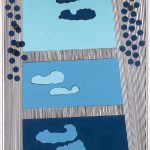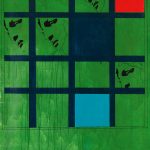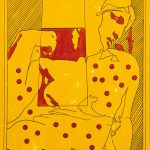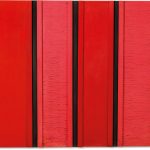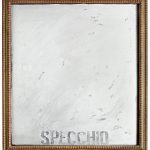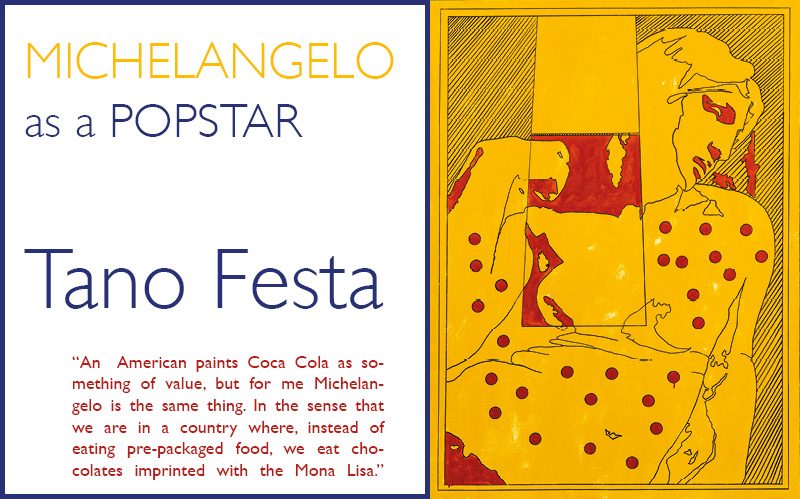
Mona Lisa on chocolate: Alongside Mario Schifano, Tano Festa was one of the most eminent protagonists of the Roman scene in the 1960s and 1970s, the “Scuola di Piazza del Popolo”. Among other things, he translated Pop Art and Op Art in to Italian, demystified objects and even tackled the sky.
BY MARIA CRISTINA CORSINI
“With a carefree attitude and level of authority that are truly astonishing for a young painter in his first solo exhibition, Tano Festa joins that important small group of Italian and international painters who work at the intersection between the neo-Dadaist, neo-geometric and neo-realist movements.” So wrote Cesare Vivaldi in his introduction to the catalogue for Tano Festa’s first solo Exhibition at Gian Tomaso Liverani’s La Salita Gallery in May 1961.
The exhibition showed works whose many monochrome and slightly rippled red and black surfaces were divided by rectangles made from painted wood. They were equally reminiscent of Mondrian and the strictness and typically American spirituality of Barnett Newman and Ellsworth Kelly.
Between 1963 and 1965, various Major galleries dedicated exhibitions to Tano Festa: in March 1963, it was the Galleria Schwarz in Milan (which showed another Festa solo exhibition in 1966); in May, it was the Galleria La Tartaruga run by Plinio De Martiis in Rome (which would later give the group of young Roman Pop Artists its name after moving to the Piazza del Popolo); and in Paris, Festa exhibited at Galerie J.
Around 1963 the artist moved on from monochrome paintings crossed with relief-like vertical lines to objects that simply served as the ground for his painting. Cupboards, mirrors, doors and windows, but also pianos, obelisks and gravestones were “created” by that they will never work. (…) My piano has wooden keys that cannot move, the mirrors in my wardrobes do not reflect images, the wardrobes themselves do not contain anything and no light comes through my windows.”
In a famous letter Festa wrote to Arturo Schwarz in 1966, the artist explained that he had expressed himself for two years “by means of objects” and had used “painting only to colour them”. He also described how this obsession had taken hold of him when he, while walking through a narrow street in Rome, had caught sight through a bookshop window of a reproduction of Van Eyck’s “The Arnolfini Wedding”. It was not the figures that attracted him, but rather the huge chandelier at the centre of the paining. To Festa, it symbolised inevitability and the transience of human existence. This object would survive the married couple and became a central object of his Obsession.
From 1964, Festa shifted his focus ever more to iconographic narration, which has many similarities with young American Pop Art. “In 1964 I created a series of paintings relating to Michelangelo (…). When these Michelangeli were made – and, by the way, I never visited the Sistine Chapel – Rome and the type of painting consumed here were formative for me. (…) An American paints Coca Cola as something of value, but for me Michelangelo is the same thing. In the sense that we are in a Country where, instead of eating pre-packaged food, we eat chocolates imprinted with the Mona Lisa”. (Interview with Tano Festa, Giorgio De Marchis, April 1967)
“An American paints Coca Cola as something of value, but for me Michelangelo is the same thing. In the sense that we are in a country where, instead of eating pre-packaged food, we eat chocolates imprinted with the Mona Lisa.”
TANO FESTA
Festa schematically and mechanically reproduced these michelangelesque elements (a detail from “The Last Judgement”, the allegory of “Night” in the Medici chapel etc.) by recreating them with the help of photography or from memory.
His observation and processing of objects in the room shifted to the outside and became an observation of external objects in museums and on squares – eventually extending fully into large spaces and ultimately including the dimension of the sky.
From 1965 the sky – over New York, for example – was at the centre of a series of paintings. “Cielo meccanico” (“Mechanical sky”) and “Le dimensioni del Cielo” (“The dimensions of the sky”) are “no Impressionist products of the spirit, but rather static diagrams of nature. A yardstick is applied to the blue sky because of the compelling urge to measure everything, and because the sky itself is a product of man.” (Maurizio Fagiolo dell’Arco, 1966)
Festa added shutters, doors and scurrilous collections of spheres to the sky, associating these spheres with the optical art popular when he visited New York in the 1960s.
Maria Cristina Corsini is specialist in modern and contemporary art at Dorotheum.

